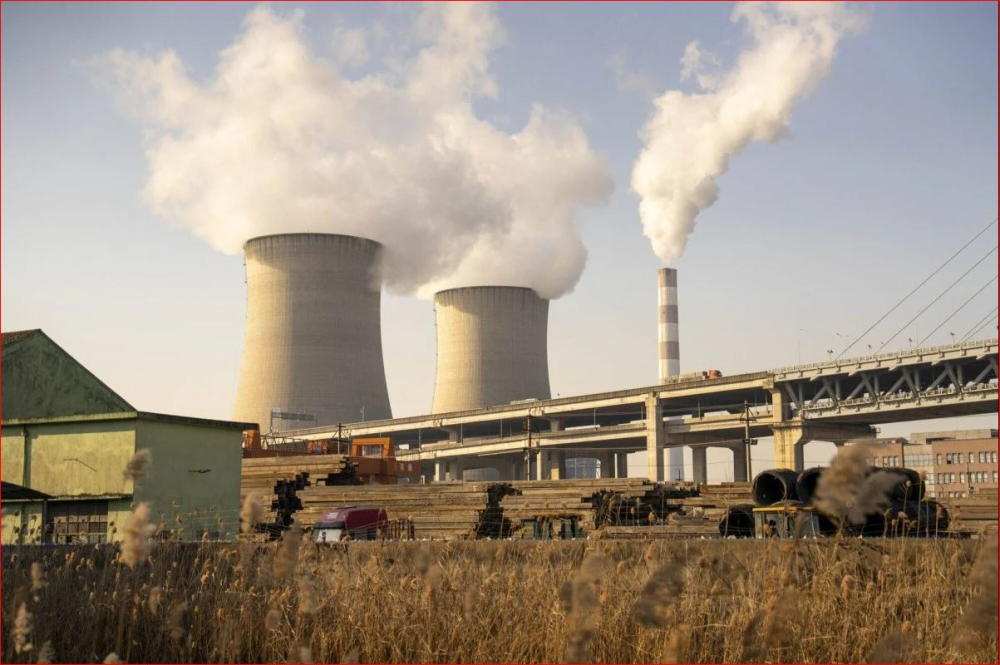
We use Google Cloud Translation Services. Google requires we provide the following disclaimer relating to use of this service:
This service may contain translations powered by Google. Google disclaims all warranties related to the translations, expressed or implied, including any warranties of accuracy, reliability, and any implied warranties of merchantability, fitness for a particular purpose, and noninfringement.

Highlights
- Recently, China has increased investment in solar energy, wind energy and electric vehicles as the 'New Three', the production of electric vehicles increased by 36 percent in 2023, 9.6 million units of electric vehicles were produced in 2023.



China is the largest emitter of greenhouse gases, which have played a major role in warming the earth over the past two decades. However, in recent years, China has been rapidly reducing greenhouse gas emissions. The way that emissions data used to form a mountain peak has now become a flat plateau.

The effects of climate change can be large-scale. In 2006, China's emissions overtook the US, increasing its global share to nearly one-third. Even when accounting for population differences, emissions numbers were large. According to recent public data released by the Chinese government as well as reports by energy analysts, China's emissions are not expected to decrease significantly, but there are indications that they will not increase. It is also seen as a big success. Chinese President Xi Jinping has promised to reach that situation by 2030.
China has made the biggest shift in electricity generation to reduce greenhouse gas emissions. In short, renewables are replacing coal in China. Coal is the most polluting fossil fuel. China last year alone installed more solar panels than the US has ever installed. And, most of them were connected by China to its electricity grid.
According to the report published last week by the Global Energy Monitor, about two-thirds of the large wind and solar plants currently under construction in the world are in China. This is more than eight times the planned wind and solar capacity in the US. Last May, China produced 53 percent of its electricity from coal. This is the lowest since the Chinese government began publishing energy data decades ago. According to Belinda Scape, a China analyst at the Center for Research on Energy and Clean Air, this data can also be understood as the fact that China has passed the peak of greenhouse gas emissions.
 However, according to some observers, using the word 'peak' to describe China's current situation is a misnomer. "We've been talking about a peak for about a decade," said Li Suo, director of the China Climate Hub at the Asia Society Policy Institute. According to Li, China's emissions are more likely to plateau. According to him, this has become possible because coal has been replaced by renewable energy in electricity generation. In addition to this, among other factors, the overall energy consumption has also decreased due to the crisis in China's real estate business and the slowing down of the economy after the Corona epidemic. Due to this, the emission figures may be stable and may be only temporary.
However, according to some observers, using the word 'peak' to describe China's current situation is a misnomer. "We've been talking about a peak for about a decade," said Li Suo, director of the China Climate Hub at the Asia Society Policy Institute. According to Li, China's emissions are more likely to plateau. According to him, this has become possible because coal has been replaced by renewable energy in electricity generation. In addition to this, among other factors, the overall energy consumption has also decreased due to the crisis in China's real estate business and the slowing down of the economy after the Corona epidemic. Due to this, the emission figures may be stable and may be only temporary.
'If we look at China's emissions in the past two decades, the construction of houses and large infrastructures was going on at a rapid pace, and the supply chain of the materials needed for that is one-third of all emissions,' he said, 'according to him, it has decreased now.' More reliable signals have been obtained from the policy changes. New restrictions on permits, especially for steel factories operating coal-fired blast furnaces, could have far-reaching implications. A huge increase in the production of electric vehicles has also reduced the demand for oil.
But ultimately, how quickly China can displace coal-fired power generation will determine how much emission reductions are projected. Although the use of coal is decreasing, China is still investing in it as an energy source. China alone accounted for two-thirds of the new coal mines operating in the world last year alone. In 2023, China built the highest number of new coal-fired plants in eight years. If China were to build all the others it has proposed, it would add up to a third of what it currently has in operation. Today, China accounts for nearly 60 percent of the world's coal consumption.
 China has invested in coal mines to provide alternatives if wind and solar production decline. In addition, China is also investing heavily in 'pumped hydro' hydropower. Pumped hydro is a method of pumping water into reservoirs for storage during periods of low electricity demand and generating more electricity when demand increases. Those systems can help reduce demand for coal power during times of high energy demand. Oil and gas are also used as energy sources in Chinese industry. According to Li, both the production and import of petrochemicals are increasing in China. However, the decisive factor in China's emission projection will be possible if there is a decline in the use of coal.
China has invested in coal mines to provide alternatives if wind and solar production decline. In addition, China is also investing heavily in 'pumped hydro' hydropower. Pumped hydro is a method of pumping water into reservoirs for storage during periods of low electricity demand and generating more electricity when demand increases. Those systems can help reduce demand for coal power during times of high energy demand. Oil and gas are also used as energy sources in Chinese industry. According to Li, both the production and import of petrochemicals are increasing in China. However, the decisive factor in China's emission projection will be possible if there is a decline in the use of coal.
Chinese investment in clean technology
In 2023, the main focus of China's clean energy investment was solar power, as well as the production of solar panels, electric vehicles and batteries. The increase in clean energy investment comes as China's real estate sector contracted for the second year in a row. This shift has positioned the clean-energy industry as a key part of China's energy and climate efforts as well as broader economic and industrial policy. However, investment in clean energy cannot continue indefinitely in China's investment-based economic model. However, the growing importance of these new industries globally provides an opportunity for China to play an important economic role in clean energy technology.
Yet it raises questions for foreign policymakers trying to link their own climate strategies to domestic industrial growth. China's clean energy investment growth is responsible for growth in the country's overall economy in 2023. China is estimated to have invested 6.3 trillion yuan (about US$890 billion) in the clean energy sector in 2023. This was a 40 percent increase over the 4.6 trillion yuan investment in 2022. Clean energy accounted for 13 percent of China's large real estate investment in 2023, up from just 9 percent the previous year. Overall, Chinese investment only increased by 1.5 trillion yuan in 2023, the analysis shows. In that, clean energy has contributed to all the growth. While investment in areas like real estate has decreased.
 Clean energy is also a top contributor to China's overall economic growth. which contributed 40 percent of the annual growth in gross domestic product across all sectors. Including the value of goods and services, the clean energy sector contributed an estimated 11.4 trillion yuan (about US$1.6 trillion) to China's economy in 2023. Which has increased by 30 percent annually. This means that clean energy accounted for 9.0 percent of China's GDP in 2023, up from just 7.2 percent in 2022.
Clean energy is also a top contributor to China's overall economic growth. which contributed 40 percent of the annual growth in gross domestic product across all sectors. Including the value of goods and services, the clean energy sector contributed an estimated 11.4 trillion yuan (about US$1.6 trillion) to China's economy in 2023. Which has increased by 30 percent annually. This means that clean energy accounted for 9.0 percent of China's GDP in 2023, up from just 7.2 percent in 2022.
In 2023, if the clean energy sector did not contribute to China's economic growth, China's GDP would have grown by only 3.0 percent instead of 5.2 percent. It would have missed government growth targets at a time when concerns about the country's economic prospects have grown, the housing market is in crisis and the population is shrinking. Due to the key role played by clean energy in boosting growth in 2023, it has now become a key component of China's economic and industrial development. This has the potential to strengthen the achievement of China's 'double carbon' targets for 2030 and 2060 by increasing its economic and political relevance as well as its climate and energy policies.
Solar power was the largest contributor to the growth of China's clean-tech economy in 2023. It raised a combined equivalent of one trillion yuan through new investment, goods and services. Because its value increased from 1.5 trillion yuan in 2022 to 2.5 trillion yuan in 2023. This is an annual growth of 63 percent. China has dominated the manufacturing and installation of solar panels for years. But the growth of this industry in 2023 was unprecedented. The two programs of the federal government named 'Solar Energy Distribution in All Wards' and 'Swachh Urja Aadhaar' have contributed greatly to the establishment of solar energy.
In response to the slowdown in real estate business, the central government introduced a new policy in early 2023 to encourage the development of solar energy industries on unused land. Meanwhile, during the annual legislative sessions in the spring of 2023, 15 states prioritized the development of the solar energy industry on their government agendas. An estimated 200 GW of solar power was added in 2023. It was only 87 gigawatts in 2022.
In 2023, China had a significant increase in the export of solar energy products. It exported 56 GW of solar wafers, 32 GW of cells and 178 GW of modules in the first 10 months of the year. Which is an annual growth of 90, 72 and 34 percent respectively. However, the export value of these solar products has increased by only three percent due to the decrease in cost. In addition, China has also invested significantly in wind energy. China installed 41 gigawatts of wind power capacity in the first 11 months of 2023. Which is an annual increase of 84 percent. According to China Galaxy Securities, 6 gigawatts of energy was obtained from wind power plants to be installed on land in 2023, compared to the previous year.
 China has increased its investment in solar energy, wind energy and electric vehicles as the 'New Three'. Production of electric vehicles increased by 36 percent in 2023. In 2023, 9.6 million units of electric vehicles were produced. Which is a total of 32 percent of all vehicles produced in China. Most of the electric vehicles produced in China are sold in China. Although the subsidy given for the purchase of electric vehicles in 2020 ended in 2022, there has been no decline in its consumption. China's EV market is highly competitive. There are over 300 models available from at least 94 brands. Domestic brands account for 81 percent of the EV market. Among them, BYD, Bulling, Cherry, Changan and GAC are the top producers.
China has increased its investment in solar energy, wind energy and electric vehicles as the 'New Three'. Production of electric vehicles increased by 36 percent in 2023. In 2023, 9.6 million units of electric vehicles were produced. Which is a total of 32 percent of all vehicles produced in China. Most of the electric vehicles produced in China are sold in China. Although the subsidy given for the purchase of electric vehicles in 2020 ended in 2022, there has been no decline in its consumption. China's EV market is highly competitive. There are over 300 models available from at least 94 brands. Domestic brands account for 81 percent of the EV market. Among them, BYD, Bulling, Cherry, Changan and GAC are the top producers.
(with the help of agencies)
 प्रकाशित : श्रावण १८, २०८१ ०९:११
प्रकाशित : श्रावण १८, २०८१ ०९:११

 २७.१२°C काठमाडौं
२७.१२°C काठमाडौं











